In business, innovation often results when ideas are applied in order to further satisfy the needs and expectations of customers. Innovation is now recognised as the single most important ingredient in any modern economy. Innovation in itself has evolved from being product and service focused to being seen as a pivotal management tool across virtually all industries and market segments.
Serial Innovation is built on the principles of continuous improvement and operational excellence to promote innovation across all business functions within an organisation. This section looks at what is driving innovation in businesses, which industries are the most innovative and why and how South Africa fares as an innovative nation.
Innovating to stay ahead
With the speed of change today, a competitive advantage can be short-lived. If a company is not planning ahead with its next innovation, it is already behind the curve. Supply chain excellence has always been about balancing costs and service levels. Reducing costs remains important but companies are increasingly using their supply chain to drive business strategy and achieve their objectives. As the supply chain is critical to delivering products and services to customers, there is a need to constantly innovate new processes to effectively serve changing consumer demands and market conditions.
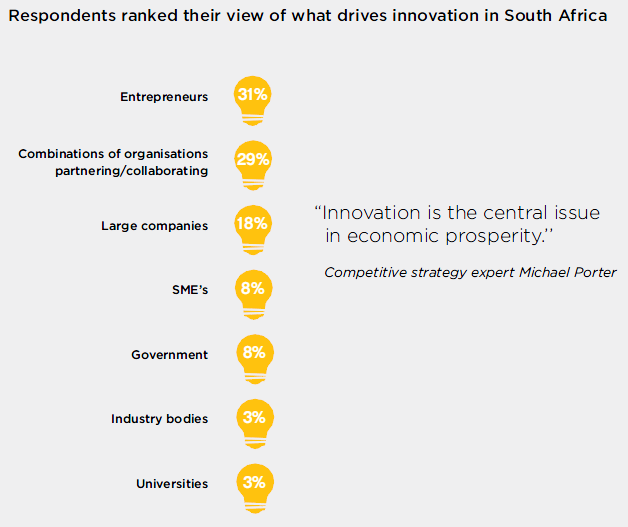
Respondents to the 2013 supplychainforesight survey cited entrepreneurs and smart partnerships as the real drivers of innovation but have little confidence in government, industry bodies and universities’ ability to drive innovation.
Research and development (R&D) has traditionally been the domain of government, universities and R&D departments but its tentacles are spreading into all areas of business, from boardrooms to the factory floor, and are fast becoming the DNA of successful organisations world-wide. An entrepreneurial mindset in both large corporations and start-ups is now a standard and essential requirement. Companies of all sizes will struggle to compete if they fail to adopt a more entrepreneurial approach.
Innovation has moved from a product and technical focus to optimising business processes and systems to satisfy a real or perceived customer need. Entrepreneurship and innovation are two of the most valuable currencies in the 21st century.
Innovation constraints
In South Africa, the risks and uncertainty brought about by political, economic and social instability force businesses to innovate over the short rather than long term. This is also driven by pressure on margins, the costs associated with long-term investment in research and development, and the need to achieve a quick return on investment. Innovation is driven by the constant pressure to keep up with the market and stay ahead of the competition rather than only focusing on groundbreaking initiatives.
Innovation within supply chains
Seventy-three per cent of respondents said they regularly evaluate and modify their supply chain strategy to align with their business strategy. But 51% don’t feel that their organisations innovate within the supply chain and logistics functions regularly enough. This is a concern for companies wanting to retain their competitive advantage.
An increase in marketing respondents highlights that the supply chain is becoming a source to create the very value they seek to attain. Supply chain initiatives are a combination of cost control and service enhancements enabling companies to effectively compete in an ever-changing business environment. An example of this is the systems retailers are implementing to ensure on-shelf availability. The higher cost of distribution to ensure products are always available is offset against greater customer satisfaction and increased sales.
Sufficient innovation within supply chains
Only 40% of South African companies said they innovate sufficiently. This is often due to company culture, a lack of skills and opportunity, and fear of change. Innovation in the supply chain involves both micro and macro changes and requires a flexible and adaptable environment in which change is not feared. Organisations that succeed in creating a supply chain advantage are invariably those where supply chain management and logistics are closely aligned with their business strategy.
Serial innovation in the supply chain
The 2013 supplychainforesight survey shows companies do not innovate regularly enough in the supply chain. This is less so in larger organisations who have more resources to invest in and foster a
culture of innovation.
There is a growing recognition that innovation is critical to success and is as important as mapping out competitive strategies or maintaining good margins. Having optimised operations and finances, many companies are now recognising that growth through innovation is their best strategy to compete in global markets.
“Supply chains are backbones of the global economy. Their complexity and critical role have businesses and governments increasingly concerned about managing major disruptions. This calls for a better strategy around resilience to build agile, transparent and diversified systems.” The Chief Supply Chain Officer Report 2012, a global study published by SCM World.
Innovating as a business
An entrepreneurial mindset will enable businesses to retain their competitive advantage by identifying new products for new markets, along with new systems, new processes and new ways of doing business. By combining insight into what they can offer new markets with foresight into market demands and trends, companies are able to constantly exploit new opportunities to expand and grow their business. By definition product and service innovation is often the refinement of business processes and products on a micro level, while business strategy innovation is more about a new approach to market, new positioning, new markets, new segments, new products and new sources of supply. The top rankings of product and service innovation and business strategy innovation in the survey links back to the high ranking of introducing new products and services as a strategic business objective.
Value creation through business strategy innovation will result in higher returns for an organisation.
“While incremental and product innovation have historically been the main drivers of growth for companies, business model innovation is gaining momentum within the context of today’s low-growth, resource constrained world. Strong understanding of customer needs and markets, combined with better access to talent and technologies are seen as critical to successfully innovate and unlock growth,”
GE Global Innovation Barometer, 2013 published by GE and researched by StrategyOne.
Innovation in organisations
There is a strong commitment to serial innovation with 68% of respondents saying their organisation’s commitment is either excellent or good. This demonstrates that there is a belief among respondents in their ability to continually innovate. A similar percentage of respondents said their organisation has done an excellent or good job at innovation for competitive position.
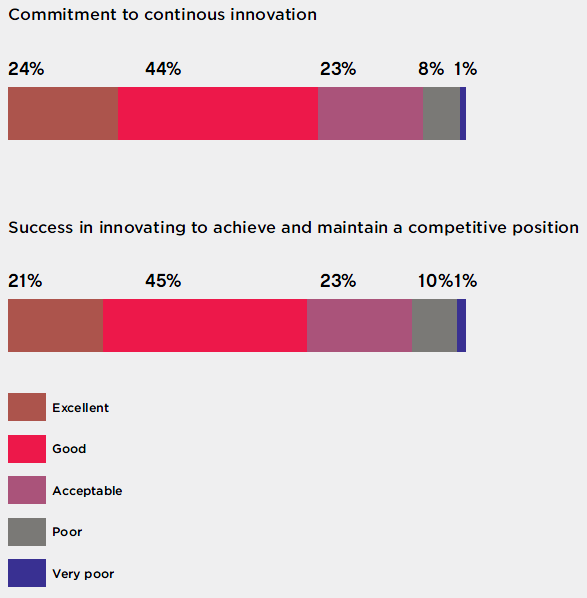
“Serial Innovation is built on principles of continuous improvement and operational excellence to promote innovation across all business functions within an organisation.” Barloworld Logistics
South African organisations’ general attitude and approach to innovation
The graph shows a broadly positive response that a majority of corporate cultures actively encourage innovation. It also shows the strong desire to innovate in South Africa is constrained by risk adversity, a short-term focus, pressure on margins and a lack of support. It would appear that innovation in some industries or organisations is driven by a compelling event that could threaten a company’s survival.
In South Africa, the automotive industry has one of the highest levels of existing innovation programmes and where it doesn’t, it plans to. To counter the threat of globalisation and remain competitive and viable as a global supplier, the South African automotive industry continually innovates through collaborative initiatives and smart partnerships. It is encouraging that the majority of companies plan to implement structured innovation programmes. Government services and state owned enterprises rank lower in terms of plans for future innovation. Large companies in South Africa currently have the most structured approach to innovation. Smaller companies are catching up though as they are recognising the need to innovate to gain a competitive advantage.
Innovating as an industry
All businesses within an industry need to work together to innovate collectively in order to keep up to date with global industry trends and compete on an international level. The rapid growth in technology-based industries is being fuelled by deregulation, cost reductions and investment in infrastructure, which allows businesses within specific industries to constantly innovate as an industry and compete more effectively globally. For example, ever evolving technology and the convergence of cellular providers within the telecommunications industry has fuelled mobile phone growth in Africa.
Today mobile phones account for 90% of all telecommunications in Africa. Cellular service providers are now leveraging their position in the market to become the preferred data providers as well. (Statistics sourced from KPMG’s Telecommunications in Africa) By the same token serial innovation in the retail industry is driven by increasing demands from more informed customers and the availability of more products to choose from, which is creating greater competition.
“Innovation is the process of turning ideas into manufacturable and marketable forms.” Watts Humphrey
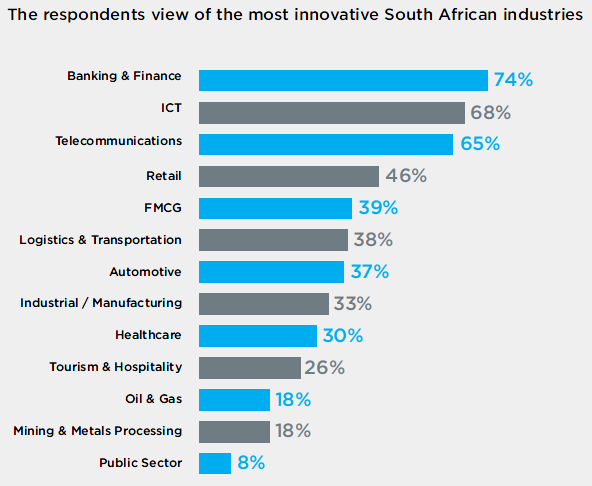
Innovating as a country
For South Africa to innovate on a larger scale, a more institutionalised approach to innovation is needed. Underpinning the entire concept of institutionalised innovation is the government’s role in creating the right economic environment to attract appropriate intellectual and investment capital within the public and private sector.
Top constraints to SA competitiveness
The graph highlights the respondents’ perceptions of barriers to our competitiveness. Some of these constraints can be fixed in the short-term whilst others require a longer term focus. To overcome these issues in the short-term, South African companies need to focus on innovation, collaboration and smart partnerships as a means to finding creative and alternative methods to continue to compete effectively.
Respondents listed education and skills as the top constraint to South Africa’s competitiveness. The skills shortage is a world-wide phenomenon and is directly impacting a company’s ability to resource appropriately for continual innovation and future growth.
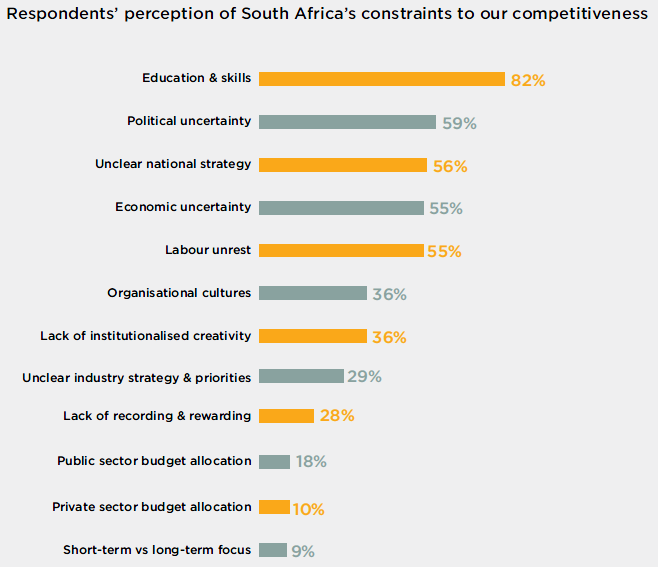
According to the 2013 GE Global Innovation Study published by GE and researched by StrategyOne, “Education, development and access to talent are a critical concern for innovation leaders. The creativity and technical prowess of the global workforce is seen as key to unlocking innovation potential across companies and countries. But concerns around the preparedness of the workforce to innovate for tomorrow’s economy abound. And cross-border talent mobility is a high priority for companies seeking to match the right job with the right people.”
Outsourcing non-core functions and forming smart partnerships with key suppliers to mitigate the risks associated with being unable to source specialist skills, is a growing global trend. In developed countries and even in some emerging markets, governments are playing an important role in supporting innovation by implementing the appropriate structures, policies and legislation. Academia and business provide the intellectual capital for serial innovation and investment capital for commercialisation. Countries such as Korea, Malaysia and Singapore are examples of innovative nations with coordinated and integrated strategies. To remain competitive in the future, South Africa needs to adopt an innovative and coordinated national strategy. This will create a vision for our future and align all facets of our nation to a goal, in which all components work together, thus creating greater growth and opportunities for all.
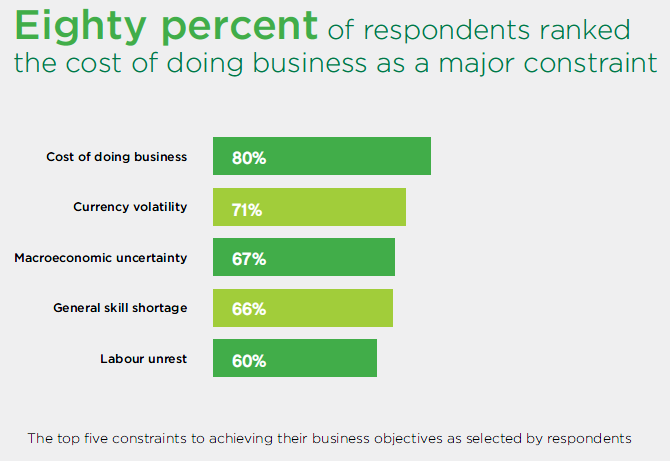
To download the complete report, please visit http://www.barloworld-logistics.com/site/industry-insight/